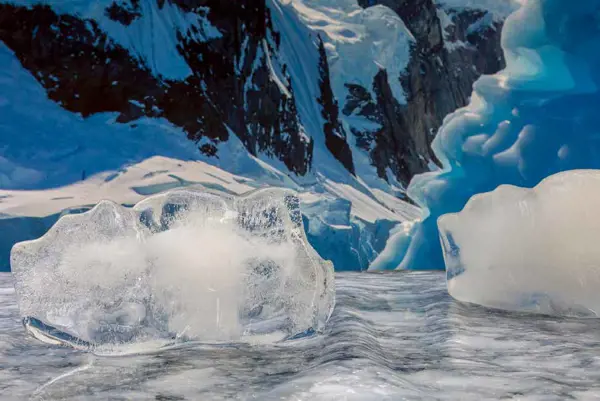

New Harmony Gallery of Contemporary Art, University of Southern Indiana is proud to present Metaphorical Antipodes: Stories of Ice featuring photography and sculpture by Indiana artist Jacinda Russell. Metaphorical Antipodes: Stories of Ice will be on view from June 10 through August 5. The exhibition opens in conjunction with New Harmony Second Saturdays on Saturday, June 10 with an artist talk at 3 pm CT and public reception from 4 – 6 pm CT. New Harmony Gallery of Contemporary Art’s open hours are Tuesday – Saturdays, 10 am – 5 pm CT.
In Metaphorical Antipodes: Stories of Ice, Jacinda Russell combines three bodies of work that document time, environments, and loss. Through photography and sculpture, each series records a different element of the rapidly-changing landscape in the polar regions. Utilizing precarious materials and embracing moments of denied access, Russell’s process reflects both the beauty of the planet and the ever-present feeling of powerlessness to protect it.
Metaphorical Antipodes – Chapter 1: The Arctic Circle and Antarctica, 2019 - 2020
As an artist with a longstanding interest in edges, borders, and topographical extremes, I have explored the impacts of human-accelerated climate change in the polar regions since 2017. In the first chapter, Metaphorical Antipodes: The Arctic Circle and Antarctica, I sculpted plasticine icebergs based on calving glaciers in Ilulissat, Greenland and the Antarctic Peninsula. They were formed into silicone molds, filled with water, frozen, and photographed on the imagery that inspired them. The molds were cast into glass, a fragile medium that mirrors the ephemerality of the ice.
My process is dependent upon the weather and its unpredictability is one of many causes for concern. I fabricate landscapes as if these actions will be the only versions left once the icecaps are gone. There is a sense of urgency in documenting the disappearances of places in peril as this affects everyone, despite our political, geographical, and cultural differences.
Metaphorical Antipodes: Svalbard 80º N, 2022
I was diagnosed with Covid five hours after setting sail on an expedition boat in the Svalbard Archipelago in May 2022. I was immediately sentenced to quarantine in a 10' x 20' cabin for seven nights. Sick and at a loss, I stared out the window for hours watching polar bear footprints recede into the horizon, a walrus emerge in the wake, and geography lacking name or direction unveil itself before me.
In October 2022, I returned as an Arctic Circle Artist in Residence, spending two weeks on a barquentine sailing vessel breathing the outside air that I was denied five months earlier. I quickly realized the ladder to reach the zodiacs was outside my cabin porthole and I made it a point to photograph my shipmates as they descended, paused and departed for land.
By focusing on the salty and icy glass, I intentionally referenced the deteriorating photographs from 19th century polar expeditions, those where the elements marred the film before development or the slow exposures blurred the subjects. This obstruction does not hide the frustration nor the anticipation of pandemic and environmental loss, marking every nautical mile traveled.
*** *** *** *** *** *** ***
Jessica Creane and Andrea Legge permitted me to use their porthole when the ladder switched to starboard. Dianne Chisholm, provided cover as I sought (and failed) to photograph every member on board
Metaphorical Antipodes – Chapter 3: The Library of Ancient Ice, 2022
The Library of Ancient Ice, continues my longstanding investigations of ice, its impermanence and fragility, and its natural and artificial presentation. Curators at the National Science Foundation’s Ice Core Facility (NSF-ICF) sent me two 1,000+ year old de-accessioned samples from Greenland and Antarctica during the COVID-19 pandemic. I built a backdrop and waited for a snowstorm to cover it with a thick layer of white. On a subfreezing February day, I opened the shrink wrap and photographed each of the cores.
Five months later, I visited the facility in Lakewood, Colorado. The most famous examples of ice on earth are housed here, including the Vostok core (where scientists detected global warming) and a 2.4 million year old slab from Allan Hills, Antarctica. I was enthralled by humanity’s attempt to preserve ice in a cold environment (-35º C) when everything around it is warming (37º C on this particular afternoon). Knowing I was unable to preserve my samples before they acquired freezer burn or dissolved in a puddle during a power outage, I documented them melting upon my return. Two metal cylinders designed after the storage tubes in the NSF-ICF hold their watery remains.
Inspired by the isotopic differences between summer (clear) and winter (foggy), I constructed my own ice core out of glass. Each disk represents every year of my life with ash from Mt. St. Helens sprinkled in between 1979 and 1980, a break when I departed my home in the Pacific Northwest for Indiana, and the largest piece symbolizing the longest year, 2020. It is displayed on a light table modeled after the one in the NSF-ICF examination room in Colorado.
When we examine ancient ice, we are viewing a record of what the atmosphere looked like on a given day. The sky is the source of the snow which when compacted, turns to frozen water approximately one hundred years later. Ice is our history and there will be no evidence of this once it disappears.
Jacinda Russell is a conceptual artist who seeks the edges, the ends of the line, and the blue in between. She works primarily in the mediums of photography, sculpture, installation, and bookmaking. Her artwork has been exhibited at the Atlanta Contemporary Art Center (Atlanta, GA), Texas Gallery (Houston, TX), Houston Center for Photography (Houston, TX), and the Amundsen-Scott South Pole Station (Antarctica). She is the recipient of the 2019 and 2022 DeHaan Artist of Distinction Award of the Arts Council of Indianapolis and the Photographic Arts Council / Los Angeles Research Fellowship at the Center for Creative Photography. Born in Idaho, she received her BFA from Boise State University in Studio Art and her MFA from the University of Arizona. Currently, she lives in Indianapolis and works as an Associate Professor of Art at Ball State University
New Harmony Gallery of Contemporary Art at University of Southern Indiana promotes discourse about and access to contemporary art in the southern Indiana region. New Harmony Gallery of Contemporary Art is a proud outreach partner of the University of Southern Indiana.
Photo Credit: Jacinda Russell, Charlotte Bay, Antarctica & Indianapolis, IN, 2020, Archival Pigment Print.
This exhibition is made possible in part by the Efroymson Family Fund, Arts Council of Southwestern Indiana, and the Indiana Arts Commission, which receives support from the State of Indiana and the National Endowment for the Arts.






























